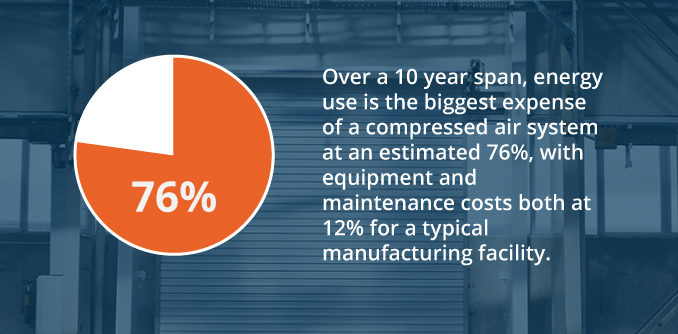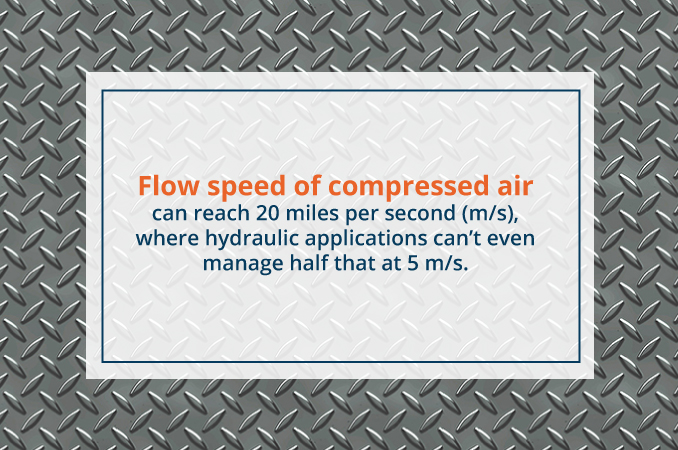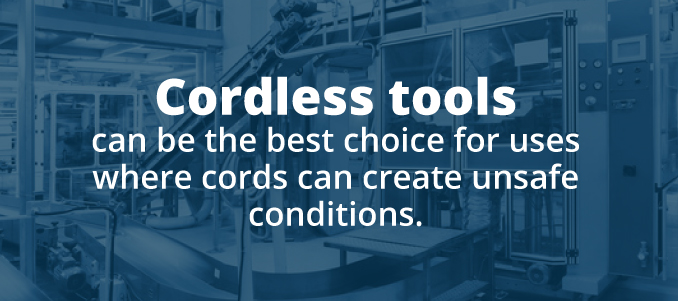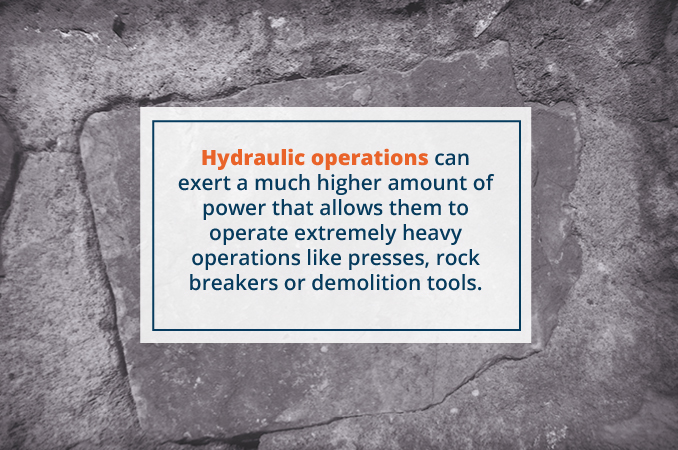
The power from an air compressor is used for a variety of applications. From the power-hungry industrial purposes of conveyor operation, pharmaceutical production or plastics manufacturing to the simple personal uses of inflating tires and equipment cleaning, you will find pressurized air working in all sorts of ways.
What Are Pneumatic Tools?
One of the most common and useful ways to use compressed air is to power pneumatic tools, also known as air tools. There are many advantages of air-powered tools which make it the ideal way to use tools in the manufacturing industry — or any environment that requires running tools for long periods of time.
While an air compressor is needed to operate air tools, the many benefits outweigh an initial cost of an air compressor, even for the home shop. As technology has advanced over the years, so has easy and inexpensive access to air tools and compressors. For some businesses, air tools are the only way to go, but other businesses need some insight into the functionality and long-term costs to determine if pneumatic tools are the best option for their use.
The biggest benefits of air-powered tools are:
- the lightweight and simple design
- the reliable source of power
- the lower costs of tool purchase and maintenance
- the versatility of use
- the safe power option
You may be trying to gather information to decide if pneumatic tools are the right choice for your work, and you’ll find lots of information here to help you decide. Whether you’re looking for a comparison to electric tools or hydraulic tools, we’ll provide you with detailed facts and comparison lists to help you discover the advantages and disadvantages of air tools.
Lightweight, Simple Design
Since each air tool doesn’t have a motor of its own (because it runs off the power from the air compressor), air tools are significantly lighter in weight than their electric counterparts. This is especially advantageous for those who use tools for a long period of time. Pneumatic sanders, grinders, spray guns and sand blasters are just a few of the tools that are run continuously in a variety of environments.
Without the extra bulk of a motor, you will experience less muscle fatigue and have better control over the operation of the tool, even after a long day. You will also get the benefit of an ergonomically-focused design that will be better to grip and pivot during use, and the smaller size makes it easier to complete a range of specific applications.
All pneumatic tools also boast a much simpler design than electric tools, which results in less breakdown, easier repair and longer life. Whether you’re using air tools in your home shop or you have hundreds of tools operating in a production line, this is a huge benefit when you’re considering the long-term costs of tools. Other qualities that relate to the lightweight, simple design of air tools are:
- Easy to hook up
- Very low occurrence of malfunctioning (no overheating, short-circuiting or risk of electrocution)
- Quick user training
- Easy to maintain since there are fewer moving parts
Enjoy the Lower Costs
There are certainly circumstances when you will see lower energy costs with electric tools, especially with irregular use for low-power operations, like using a brad gun or drill. However, when tools are used continuously, air-powered tools are the most cost-effective in the majority of situations.
You will see the most savings for professional applications in both the cost of the tools and in energy consumption. There are many ways energy costs can be controlled in an air compressor system, and it’s your best way to keep costs down.
Over a 10-year span, energy use is the biggest expense of a compressed air system at an estimated 76%, with equipment and maintenance costs both at 12% for a typical manufacturing facility.
If you’re using just one or two tools in your shop on an occasional basis, you won’t benefit from the lower costs of pneumatic tools. However, the reliable power supply and low rate of tool burnout may be the benefit that is more attractive to your situation.
Putting the cost of the air compressor aside, the initial purchase of an air tool as well as the maintenance and frequency of replacement are all lower than that of the electric equivalent.
Reliability When It Counts the Most
From increased power potential to the stability of a well-maintained compressor system, air-powered tools are a reliable way to get work done. The biggest advantage of air-powered tools for the industrial market is the dependability of continuous use — less breakage and maintenance mean less downtime.
Even an auto repair shop or a woodworking facility, that may not have as much urgency to keep production up as a multi-million-dollar organization, will be inconvenienced and experience a loss in profits when their tools and power system let them down. When comparing air-powered tools vs. electric, air tools come out on top for reliability in power supply and equipment uptime.
A Versatile Option for Any Environment
Air tools can easily adapt to any environment, even if there is no electricity to run an air compressor. The versatility of compressed air as a power source is unmatched by other power sources such as electricity, natural gas and highly-flammable gasoline. Compressed air can be stored in cylinders, which may be used as the power source for air tools in places such as an oil rig or mine.
Although the air lines can be an issue in some situations, the reliability of compressed air as a power source makes pneumatic tools the ideal choice for a wide range of applications, whether by using reliable electric hook up to run a compressor or by using tanks of compressed air.
With the ability to adjust the pressure through the air compressor, you can easily switch tasks from high-powered sandblasting to low-powered cleaning with speed and ease. You’ll also be able to disconnect and reconnect your air tools quickly, allowing for more efficient practices and a higher production rate.
Many industries need the clean and dry power of compressed air that hydraulic systems do not provide. Soiling products with oil or other contaminants is unacceptable in many industries like food, packaging, leather and textiles.
Air compressor systems also allow for the higher conversion of energy into work when compared to hydraulic operations. The flow speed of compressed air can reach 20 miles per second (m/s), where hydraulic applications can’t even manage half that at 5 m/s. This benefit won’t be relevant for all uses of power tools, but for those applications where quality production can happen at higher speeds, air tools are a welcome solution with economic benefits that affect manufacturers and consumers.
The Safer Way of Air Power
Compressed air works just as efficiently when there are extreme temperatures, either hot or cold, and when there are great fluctuations in temperature.
There are a number of environments where electric tools can’t be used due to the high risk of explosion, fire and other electrical hazards, including:
- In mines
- In damp or wet conditions
- For energy exploration
- Around flammable or explosive materials
Even when the pneumatic tools aren’t connected properly or are used carelessly, there isn’t a negative impact on the rest of the air compression system. Unlike the dangers associated with electric tools, pneumatic tools have very little risk.
As with any tool, and for your own safety, you should have the appropriate knowledge of how to use the tool for its intended purpose. However, when looking at the overall system, there is very little in the way of excessive wear or overheating the system to be concerned about.
Advantages of Air-Powered Tools vs. Electric Tools
Electric tools certainly have their place for both personal and professional use. With the technological advances in battery power, cordless tools can be the best choice for uses where cords can create unsafe conditions. If you don’t need greater power and reliability that can be provided with air tools, then you may see the electric option is sufficient for your use.
Air tools are more common in professional environments, especially in manufacturing, as well as auto and woodworking shops. Here are the main advantages of pneumatic tools in comparison to electric:
- Cost: With fewer moving parts and simpler designs, air tools are cheaper to purchase and maintain.
- Flexibility: Compressed air can be used in a variety of environments and in a variety of ways as a power source. You can use stored compressed air for remote areas, and you can change tools and tasks quickly with the dependable air line that’s always ready for fluctuations or steady long-term supply.
- Maintenance: Being comprised of fewer components, the tools themselves require little maintenance or repair. The air system does need to lubricate the air with an aerosolizing lubricating oil, which prolongs the life of the tool by reducing friction. While electric tools don’t have much in the way of maintenance, repairs are much more common, as are complete tool failures.
- Safety: Air tools always run cooler than electric tools and completely eliminate hazards like electric shock and the risk of fire. They will also never get overloaded or stall, which can lead to all sorts of unsafe situations and leave you with one less tool.
- Weight: Air tools generally boast a higher rate of production due to their lighter weight and lower worker fatigue. Electric tools tend to have a bulky design to include the motor, and the design gets bulkier the more powerful they get.
- Increased power-to-weight ratio: Pneumatic tools offer improved torque levels and more revolutions per minute (RPM) than similar size cordless and electric devices.
Advantages of Air-Powered Tools vs. Hydraulic Tools
In the industrial industry, especially in manufacturing, high-powered hydraulic systems can be used in place of compressed air systems. Hydraulic operations can exert a much higher amount of power that allows them to operate extremely heavy operations like presses, rock breakers or demolition tools. They could be the best option for some applications, but there are several applications that can be handled appropriately by either pneumatics or hydraulics. Here are the main advantages of using air-powered tools over hydraulic-powered tools:
- Cost: With fewer moving parts as well as a simpler design of the air tools and the whole air compression system, there are fewer components, which lower service and maintenance costs. There can also be cost savings when considering a single compressed air system can operate a variety of other systems at once. Hydraulic systems have more complex and expensive controls.
- Flexibility: Simpler installation and interchanging of tools make for easier and quicker training for the operator. It’s also easier to expand a compressed air system to accommodate a growing operation and use air power for a wider range of applications.
- Maintenance: Much less preventative maintenance is needed for air systems where hydraulic fluids must be regularly monitored and replaced. Also, less downtime is experienced with a compressed air system due to the less complicated controls and minimal preventative maintenance required.
- Safety: A compressed air system operates with lower pressures in a variety of environments and doesn’t pose any danger from accidental air leaks. Hydraulic systems aren’t suitable for operation around high temperatures or fire hazards (although fire-resistant fluids can make it safer). A leaking hydraulic system also releases dangerous contaminants and can cause a complete system shutdown.
- High power-to-weight ratio: Air tools have a high ratio of power-to-weight that lowers operator fatigue.
Advantages of Pneumatic Systems
Apart from powering air tools, pneumatic systems use the force of compressed air to perform all kinds of operations like opening and closing clamps, moving presses to form metals and plastics, and fastening components with assembly torque tools. This air power has been a welcome solution for many challenges, whether it was to do with safety concerns, consistent power flow or efficiency in production.
The advantages of pneumatic power supply many industries with a reliable method of getting work done in the most efficient manner. With the proper air compression system, many people enjoy the convenience and ease of the power produced for their air tools. However, while the air tools are simple in design and are easy to learn how to use, the air compressor can be a trickier part to understand.
Choosing the Right Air Compressor for Your Pneumatic Tools
The right air compressor is also needed to supply appropriate power for the use of air tools. Picking the right one is mainly dependent on the cubic feet per minute (CFM) rating, which measures the volume of air the compressor can produce, and the pounds per square inch (PSI) rating, which measures the force of the air delivered by the compressor.
If you’re considering the switch from electric tools to air-powered tools and you don’t yet have an air compressor or you only have a small one that’s not sufficient for your needs, don’t let the initial cost of an air compressor hold you back. With a careful analysis of the savings in tool cost and repair and the added benefit of compressed air to use for a multitude of other tasks, you’ll likely find that the cost of a quality compressor will not be much of a disadvantage in the long run.
Pneumatic tools are only as productive and efficient as the compressors powering them. Some things to consider when choosing a compressor for your application are:
- Checking compressed air volume: Air-powered tools do not rely on horsepower, unlike many other industrial tools. Instead, a pneumatic tool’s efficiency depends on compressed air volume, which is the cubic feet per minute (cfm) at a particular pound-force per square inch gauge (psig).
- Determining the cfm for each tool: The ideal air compressor should be able to power all your pneumatic devices, including several of them simultaneously. Before choosing a specific compressor model, record the manufacturer’s recommended cfm for each one. If you cannot find the requirements on the tool, consult the product manual or manufacturer’s website.
- Calculating the total cfm needed: Once you determine the cfm requirements for each air tool, calculate the sum of the cfm of the tools you plan to operate simultaneously. Additionally, consider adding an extra 25% to the total in case you want to expand operations later.
- Establishing psig requirements: You can use the tool with the highest psig requirement as the baseline measurement for determining the appropriate psig. Most two-phase compressors provide a maximum pressure rating of 175 psig, while many single-phase compressors top out at 135 psig.
- Checking motor compatibility: The air compressor’s motor must be compatible with your facility’s power supply. While some residential or commercial buildings may have single-phase outlets, many well-equipped industrial sites offer three-phase power supplies.
- Determining air compressor tank size: As a general rule, the ideal tank size should be a minimum of 5 gallons per cfm.
- Considering the environment: Compressors with electric features should only operate in areas with regulated temperatures. You should also consider sound levels and space requirements before making your final selection.
Air-Powered Tools for Home Use
Although pneumatic tools were primarily popular in industrial populations decades ago, many of today’s hobbyists and do-it-yourselfers have turned to them because of their convenience, ease of use and efficiency. Although the initial investment of a compressor may appear high for residential applications, it could pay itself off quickly, depending on the frequency of use.
Compressed air tools provide time and money savings that many conventional options fail to offer. These tools are especially beneficial for do-it-yourself applications like car repairs, painting, roofing, carpentry and more. Pneumatic tools also provide superior cleaning ability with blower attachments.
Contact Quincy Compressor Today
At Quincy Compressor, we have professionals available to discuss the various options that would work best for your applications. Contact us online today to get all the information you need to get the right air compressor for your air tool use.





